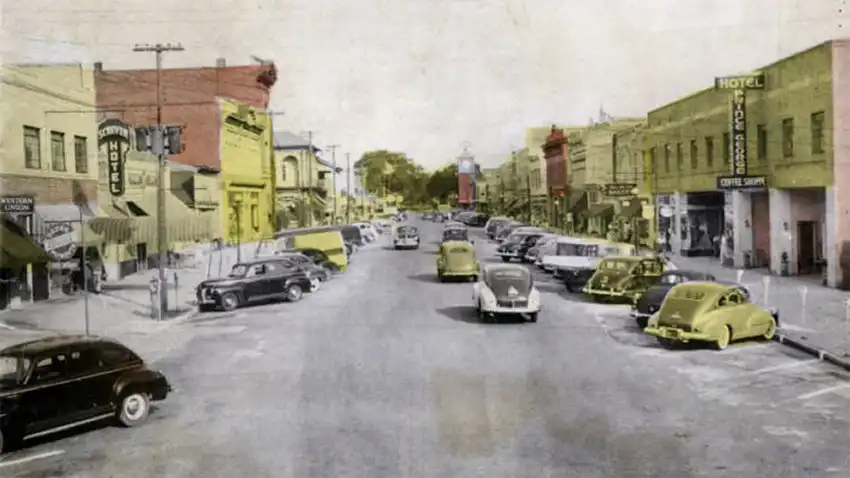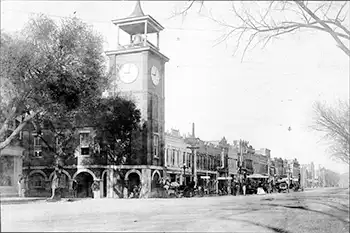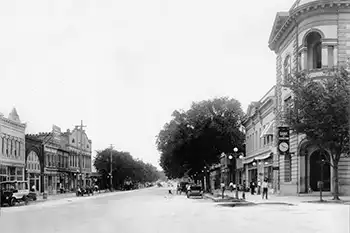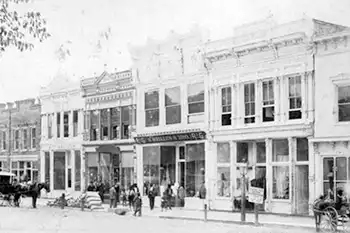
When the port city of Georgetown was laid out in 1729, merchant-oriented businesses and homes lined the land side of Front Street, originally called Bay Street, overlooking the sparkling Sampit River, which by 1732 became a main point of entry for commercial trade. By the mid-18th century, property owners realized the capital that could be gained by selling their riverside parcels of land for development and so the district expanded with additional shops where craftsmen made and sold wares such as wagons, wheels, silverware, furniture, clothes and hats.
Before the Turn of the Century
 Then, from July 1780 to May 1781, according to historian Paige Sawyer, British troops occupied Georgetown and upon their retreat, military officer, planter and politician Thomas Sumter gave his soldiers permission to reclaim the town and treat British loyalists with great disdain. In retaliation, British troops returned on the Peggy, captained by a Royalist ship captain named Mason, to burn down the buildings on Front Street. Fire resulting from a cannonball shot from the Peggy swept through Georgetown, destroying a further 42 homes.
Then, from July 1780 to May 1781, according to historian Paige Sawyer, British troops occupied Georgetown and upon their retreat, military officer, planter and politician Thomas Sumter gave his soldiers permission to reclaim the town and treat British loyalists with great disdain. In retaliation, British troops returned on the Peggy, captained by a Royalist ship captain named Mason, to burn down the buildings on Front Street. Fire resulting from a cannonball shot from the Peggy swept through Georgetown, destroying a further 42 homes.
Sawyer said that following this destruction, it took a full 50 years for residents to recover and rebuild the once thriving port city. Then tragically in 1840, only a decade after the district’s reconstruction, several other fires burned the area where the town clock and the George Hotel stand today; charred timbers can still be seen.
21st Century
 More recently, in 2013, another fire ignited along the 700 block of Front Street after a restaurateur had cleaned the wood decking and furniture with rags drenched in linseed oil and threw the highly-combustible materials in a plastic trash can. On his early morning walk through town, Sawyer discovered smoke coming from flames licking the walls of the structure and called 911 as he watched the fire rage, ultimately destroying eight buildings in its wake. Because of strict building codes and its location in a flood zone, that stretch of property on Front Street was never redeveloped, and today is used for events such as Music in the Park, the annual Wooden Boat Show, the Food, Beer & Wine Festival, Art in the Park, wedding receptions and other private gatherings.
More recently, in 2013, another fire ignited along the 700 block of Front Street after a restaurateur had cleaned the wood decking and furniture with rags drenched in linseed oil and threw the highly-combustible materials in a plastic trash can. On his early morning walk through town, Sawyer discovered smoke coming from flames licking the walls of the structure and called 911 as he watched the fire rage, ultimately destroying eight buildings in its wake. Because of strict building codes and its location in a flood zone, that stretch of property on Front Street was never redeveloped, and today is used for events such as Music in the Park, the annual Wooden Boat Show, the Food, Beer & Wine Festival, Art in the Park, wedding receptions and other private gatherings.
Present Day
 Despite such devastation over the centuries, today Georgetonian business owners and residents, with customary perseverance and refinement, are thriving on Front Street and beyond. For history lovers, Front Street provides a fantastic opportunity to learn about the Lowcountry’s enchanting and haunting past. Tour the Kaminski House, the Maritime Museum, the Gullah Museum, the Rice Museum and the Georgetown County Museum. To learn more about Front Street and the surrounding historical district, take a walking tour with Sawyer, who is a living textbook when it comes to Georgetown County. Visit oldgeorgetownwalkingtours.com to secure your time.
Despite such devastation over the centuries, today Georgetonian business owners and residents, with customary perseverance and refinement, are thriving on Front Street and beyond. For history lovers, Front Street provides a fantastic opportunity to learn about the Lowcountry’s enchanting and haunting past. Tour the Kaminski House, the Maritime Museum, the Gullah Museum, the Rice Museum and the Georgetown County Museum. To learn more about Front Street and the surrounding historical district, take a walking tour with Sawyer, who is a living textbook when it comes to Georgetown County. Visit oldgeorgetownwalkingtours.com to secure your time.
There is no way to explore all that Front Street has to offer in just one day, so make sure to reserve a room at The George, the first hotel to operate in 50 years on Front Street. Visit thegeorgehotelsc.com to book your stay.
By Sarah Rose



Leave a Reply